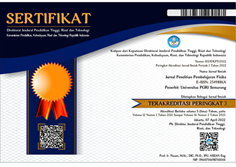Implementing Long Short Term Memory (LSTM) in Chatbots for Multi Usaha Raya
DOI:
https://doi.org/10.26877/asset.v6i4.934Keywords:
Multi Usaha Raya, chatbot, furniture, MDLC, Long Short-Term Memory, FlaskAbstract
The furniture industry is an important sector in Indonesia that supports the economy and provides quality furniture. An in-depth understanding of the furniture business is essential for industry players to improve operational efficiency and customer satisfaction. This research aims to develop a chatbot for Multi Usaha Raya furniture company to improve customer service and operational efficiency. In its development, the Machine Learning Model Development Life Cycle (MDLC) and deep learning approach using the Flask platform are employed. LSTM, a type of recurrent neural network (RNN) architecture capable of handling long-term dependencies, is utilized in this chatbot model. The model training results show an accuracy of 99%, validation accuracy of 96%, loss of 0.1%, and validation loss of 0.2% after 200 epochs, demonstrating the effectiveness of the LSTM algorithm for developing a chatbot in this company.
References
E. A. Risti, “Implementasi Pengolahan Sistem Penjualan Furniture Menggunakan Metode Design Thinking (Studi Kasus : Furniture Jati Sungu Bandar Lampung),” Jurnal Informatika dan Rekayasa Perangkat Lunak, vol. 3, no. 4, pp. 435–4459, 2022, [Online]. Available: http://jim.teknokrat.ac.id/index.php/informatika
P. Suta, X. Lan, B. Wu, P. Mongkolnam, and J. H. Chan, “An overview of machine learning in chatbots,” International Journal of Mechanical Engineering and Robotics Research, vol. 9, no. 4, pp. 502–510, 2020, doi: 10.18178/ijmerr.9.4.502-510.
F. Zakariya, J. Zeniarja, and S. Winarno, “JURNAL MEDIA INFORMATIKA BUDIDARMA Pengembangan Chatbot Kesehatan Mental Menggunakan Algoritma Long Short-Term Memory,” 2024, doi: 10.30865/mib.v8i1.7177.
P. B. Wintoro, H. Hermawan, M. A. Muda, and Y. Mulyani, “Implementasi Long Short-Term Memory pada Chatbot Informasi Akademik Teknik Informatika Unila,” EXPERT: Jurnal Manajemen Sistem Informasi dan Teknologi, vol. 12, no. 1, p. 68, Jun. 2022, doi: 10.36448/expert.v12i1.2593.
P. Anki, A. Bustamam, H. S. Al-Ash, and D. Sarwinda, “Intelligent Chatbot Adapted from Question and Answer System Using RNN-LSTM Model,” in Journal of Physics: Conference Series, IOP Publishing Ltd, Mar. 2021. doi: 10.1088/1742-6596/1844/1/012001.
I. M. Untari, “Chatbots and Government Communications in Covid-19 Pandemic.”
H. Anbiyani, F. Muhyidin, and L. Venica, “Jurnal Informatika dan Rekayasa Perangkat Lunak Pengembangan Chatbot untuk Meningkatkan Pengetahuan dan Kesadaran Keamanan Siber Menggunakan Long Short-Term Memory,” vol. 5, no. 2, pp. 152–161, 2023.
A. Silvanie and R. Subekti, “APLIKASI CHATBOT UNTUK FAQ AKADEMIK DI IBI-K57 DENGAN LSTM DAN PENYEMATAN KATA,” Jurnal Informatika dan Komputer) Akreditasi KEMENRISTEKDIKTI, vol. 5, no. 1, 2022, doi: 10.33387/jiko.
V. R. Prasetyo, N. Benarkah, and V. J. Chrisintha, “Implementasi Natural Language Processing Dalam Pembuatan Chatbot Pada Program Information Technology Universitas Surabaya,” Teknika, vol. 10, no. 2, pp. 114–121, Jul. 2021, doi: 10.34148/teknika.v10i2.370.
H. Jelodar, Y. Wang, R. Orji, and H. Huang, “Deep Sentiment Classification and Topic Discovery on Novel Coronavirus or COVID-19 Online Discussions: NLP Using LSTM Recurrent Neural Network Approach,” Apr. 2020, [Online]. Available: http://arxiv.org/abs/2004.11695
Y. Astari and S. Wahib Rozaqi, “Analisis Sentimen Multi-Class pada Sosial Media menggunakan metode Long Short-Term Memory (LSTM),” 2021.
M. A. Amrustian, W. Widayat, and A. M. Wirawan, “Analisis Sentimen Evaluasi Terhadap Pengajaran Dosen di Perguruan Tinggi Menggunakan Metode LSTM,” JURNAL MEDIA INFORMATIKA BUDIDARMA, vol. 6, no. 1, p. 535, Jan. 2022, doi: 10.30865/mib.v6i1.3527.
L. Sanny, A. C. Susastra, C. Roberts, and R. Yusramdaleni, “The analysis of customer satisfaction factors which influence chatbot acceptance in Indonesia,” Management Science Letters, vol. 10, no. 6, pp. 1225–1232, 2020, doi: 10.5267/j.msl.2019.11.036.
M. Riziq sirfatullah Alfarizi, M. Zidan Al-farish, M. Taufiqurrahman, G. Ardiansah, and M. Elgar, “PENGGUNAAN PYTHON SEBAGAI BAHASA PEMROGRAMAN UNTUK MACHINE LEARNING DAN DEEP LEARNING,” 2023.
F. Alfiansyah, S. Lina, and M. Sitio, “Implementasi Metode Multimedia Development Life Cycle (Mdlc) Pada Aplikasi Edukasi Interaktif Pengenalan Mental Health Kepada Masyarakat Berbasis Mobile.” [Online]. Available: https://journal.mediapublikasi.id/index.php/logic
A. S. Dewantara and J. Aryanto, “Implementation Of A Web-Based Chatbot Using Machine Learning For Question And Answer Services In Universities,” Advance Sustainable Science, Engineering and Technology, vol. 6, no. 1, p. 0240106, Dec. 2023, doi: 10.26877/asset.v6i1.17590.
A. N. Cahyani, J. Zeniarja, S. Winarno, R. T. E. Putri, and A. A. Maulani, “Heart Disease Classification Using Deep Neural Network with SMOTE Technique for Balancing Data,” Advance Sustainable Science, Engineering and Technology, vol. 6, no. 1, p. 0240108, Dec. 2023, doi: 10.26877/asset.v6i1.17521.
A. Daud, D. Irwanto, M. Said, M. Mubyl, and M. Mustamin, “Identification Of Chatbot Usage In Online Store Services Using Natural Language Processing Methods,” Advance Sustainable Science, Engineering and Technology, vol. 6, no. 2, p. 0240206, Mar. 2024, doi: 10.26877/asset.v6i2.18309.
J. I. T. Krisna, A. Luthfiarta, L. D. Cahya, S. Winarno, and A. Nugraha, “Comparing Optimizer Strategies For Enhancing Emotion Classification In IndoBERT Models,” Advance Sustainable Science, Engineering and Technology, vol. 6, no. 2, p. 0240203, Mar. 2024, doi: 10.26877/asset.v6i2.18228.
N. Aziza and F. B. Setiaji, “PENGENDALIAN KUALITAS PRODUK MEBEL DENGAN PENDEKATAN METODE NEW SEVEN TOOLS,” Teknika : Engineering and Sains Journal, vol. 4, no. 1, pp. 27–34, 2020.











